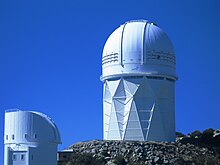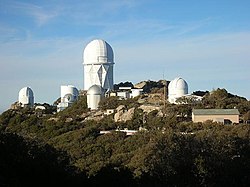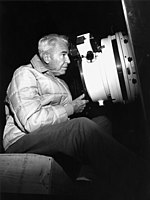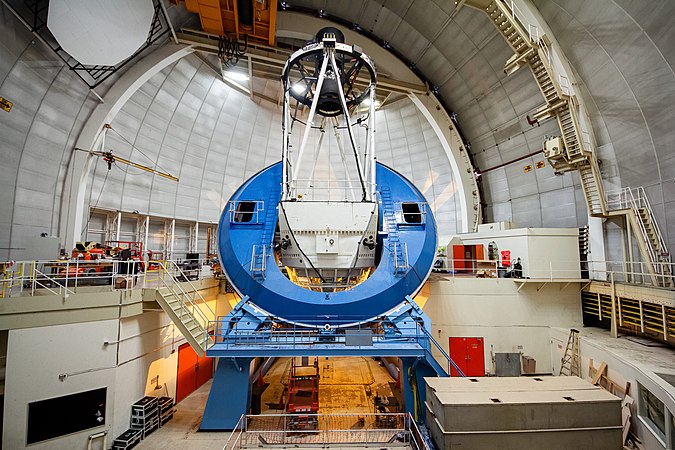
The Kitt Peak National Observatory (KPNO) is a United States astronomical observatory located on Kitt Peak of the Quinlan Mountains in the Arizona-Sonoran Desert on the Tohono Oʼodham Nation, 88 kilometers (55 mi) west-southwest of Tucson, Arizona. With more than twenty optical and two radio telescopes, it is one of the largest gatherings of astronomical instruments in the Earth's northern hemisphere.

The Very Large Telescope (VLT) is a facility operated by the European Southern Observatory, located on Cerro Paranal in the Atacama Desert of northern Chile. It consists of four individual telescopes, each equipped with a primary mirror that measures 8.2 meters in diameter. These optical telescopes, named Antu, Kueyen, Melipal, and Yepun, are generally used separately but can be combined to achieve a very high angular resolution. The VLT array is also complemented by four movable Auxiliary Telescopes (ATs) with 1.8-meter apertures.

Subaru Telescope is the 8.2-metre (320 in) telescope of the National Astronomical Observatory of Japan, located at the Mauna Kea Observatory on Hawaii. It is named after the open star cluster known in English as the Pleiades. It had the largest monolithic primary mirror in the world from its commissioning until 2005.

The Large Binocular Telescope (LBT) is an optical telescope for astronomy located on 10,700-foot (3,300 m) Mount Graham, in the Pinaleno Mountains of southeastern Arizona, United States. It is a part of the Mount Graham International Observatory.

The W. M. Keck Observatory is an astronomical observatory with two telescopes at an elevation of 4,145 meters (13,600 ft) near the summit of Mauna Kea in the U.S. state of Hawaii. Both telescopes have 10 m (33 ft) aperture primary mirrors, and when completed in 1993 and 1996 were the largest optical reflecting telescopes in the world. They are currently the 3rd and 4th largest.

The Southern African Large Telescope (SALT) is a 9.2-metre optical telescope designed mainly for spectroscopy. It consists of 91 hexagonal mirror segments each with a 1-metre inscribed diameter, resulting in a total hexagonal mirror of 11.1 by 9.8 m. However, its effective aperture is only 9.2 m. It is located close to the town of Sutherland in the semi-desert region of the Karoo, South Africa. It is a facility of the South African Astronomical Observatory, the national optical observatory of South Africa.
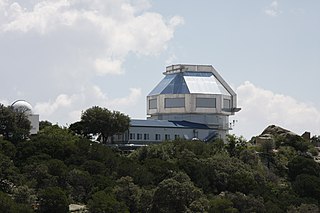
The WIYN Observatory is owned and operated by the WIYN Consortium. Its 3.5-meter telescope is the second largest optical telescope at Kitt Peak National Observatory in Arizona. Most of the capital costs for the observatory were provided by the University of Wisconsin–Madison, Indiana University, and Yale University, while the National Optical Astronomy Observatory (NOAO) provides most of the operating services. The NOAO is an institution of the United States; it is the national optical observatory program and supports a collection of ground-based telescopes at Kitt Peak as well as other locations.

The National Optical Astronomy Observatory (NOAO) was the United States national observatory for ground-based nighttime ultraviolet-optical-infrared (OUVIR) astronomy. The National Science Foundation (NSF) funded NOAO to provide forefront astronomical research facilities for US astronomers. Professional astronomers from any country in the world could apply to use the telescopes operated by NOAO under the NSF's "open skies" policy.

The Cerro Tololo Inter-American Observatory (CTIO) is an astronomical observatory located on the summit of Mt.Cerro Tololo in the Coquimbo Region of northern Chile, with additional facilities located on Mt. Cerro Pachón about 10 kilometres (6.2 mi) to the southeast. It is approximately 80 kilometres (50 mi) east of La Serena, where support facilities are located. The site was identified by a team of scientists from Chile and the United States in 1959, and it was selected in 1962. Construction began in 1963 and regular astronomical observations commenced in 1965. Construction of large buildings on Cerro Tololo ended with the completion of the Víctor Blanco Telescope in 1974, but smaller facilities have been built since then. Cerro Pachón is still under development, with two large telescopes inaugurated since 2000, and one in the final stages of construction as of 2023

The Hobby–Eberly Telescope (HET) is a 10-meter (30-foot) aperture telescope located at the McDonald Observatory in Davis Mountains, Texas.

The MDM Observatory is an optical astronomical observatory located adjacent to Kitt Peak National Observatory on Kitt Peak, west of Tucson, Arizona, in the United States. It is owned and operated by the University of Michigan, Dartmouth College, Ohio State University, Columbia University, and Ohio University. The Massachusetts Institute of Technology (MIT) was also part of the operating consortium in the past.

The Giant Magellan Telescope is a 25.4-meter, ground-based, extremely large telescope under construction at Las Campanas Observatory in Chile's Atacama Desert. Commissioning is anticipated in the late 2020s. Once complete, the Giant Magellan will be the largest Gregorian telescope ever built observing in optical and mid-infrared light. The telescope uses seven of the world’s largest mirrors to form a light collecting area of 368 square meters.
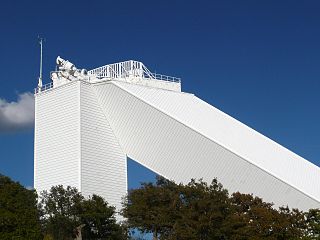
McMath–Pierce solar telescope is a 1.6 m f/54 reflecting solar telescope at Kitt Peak National Observatory in Arizona, United States. Built in 1962, the building was designed by American architect Myron Goldsmith and Bangladeshi-American structural engineer Fazlur Rahman Khan. It was the largest solar telescope and the largest unobstructed aperture optical telescope in the world. It is named after the astronomers Robert Raynolds McMath and Keith Pierce.
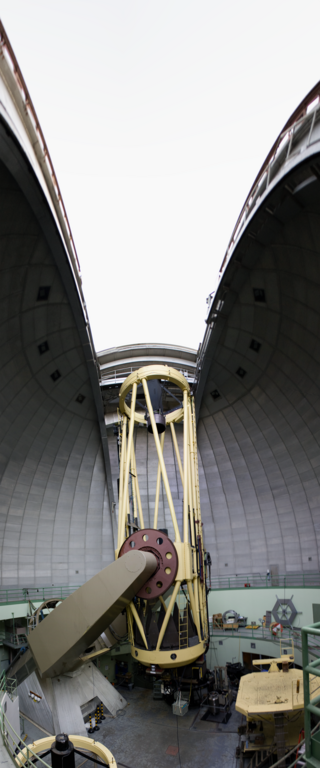
The C. Donald Shane telescope is a 120-inch (3.05-meter) reflecting telescope located at the Lick Observatory in San Jose, California. It was named after astronomer C. Donald Shane in 1978, who led the effort to acquire the necessary funds from the California Legislature, and who then oversaw the telescope's construction. It is the largest and most powerful telescope at the Lick Observatory, and was the second-largest optical telescope in the world when it was commissioned in 1959.

The Crossley telescope is a 36-inch (910 mm) reflecting telescope located at Lick Observatory in the U.S. state of California. It was used between 1895 and 2010, and was donated to the observatory by Edward Crossley, its namesake.

The Bok Telescope is the largest telescope operated solely by Steward Observatory. It finds much use from astronomers from University of Arizona, Arizona State University, and Northern Arizona University, with instruments capable of both imaging and spectroscopy. The telescope operates year-round, except during the August summer-shutdown when maintenance is performed while the weather is poor.

The Víctor M. Blanco Telescope, also known as the Blanco 4m, is a 4-metre aperture telescope located at the Cerro Tololo Inter-American Observatory, Chile on the summit of Mt. Cerro Tololo. Commissioned in 1974 and completed in 1976, the telescope is identical to the Mayall 4m telescope located on Kitt Peak. In 1995 it was dedicated and named in honour of Puerto Rican astronomer Víctor Manuel Blanco. It was the largest optical telescope in the Southern hemisphere from 1976 until 1998, when the first 8-metre telescope of the ESO Very Large Telescope opened.

Nicholas Ulrich Mayall was an American observational astronomer. After obtaining his doctorate from the University of California, Berkeley, Mayall worked at the Lick Observatory, where he remained from 1934 to 1960, except for a brief period at MIT's Radiation Laboratory during World War II.

Richard Frederick Green is an American astronomer, former director of the Kitt Peak National Observatory, UKIRT and the Large Binocular Telescope Observatory.

The Dark Energy Spectroscopic Instrument (DESI) is a scientific research instrument for conducting spectrographic astronomical surveys of distant galaxies. Its main components are a focal plane containing 5,000 fiber-positioning robots, and a bank of spectrographs which are fed by the fibers. The new instrument will enable an experiment to probe the expansion history of the universe and the mysterious physics of dark energy.
